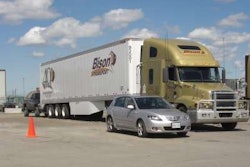DOE to spend $2.4 billion on manufacturing capacity
The U.S. Department of Energy last month announced that it will provide $2.4 billion in grants for 48 projects to expand the manufacturing capacity for advanced batteries and electric vehicle drive components and the deployment of electric vehicles. The funds, which are aimed at reducing greenhouse gas emissions and the dependence on oil, were included in the American Recovery and Reinvestment Act and were awarded through a competitive process.
Obama administration officials announced the funding Aug. 5 at various venues across the United States. President Obama himself spoke at a Navistar facility in Elkhart, Ind. Navistar will receive $39.2 million to develop, validate and build 400 advanced-battery electric delivery trucks. The trucks, which will have a gross vehicle weight rating of 12,100 lbs., will have a range of 100 miles. Navistar is in the process of finalizing a joint venture with Modec Ltd. of the United Kingdom to produce and sell all-electric Class 2c-3 commercial vehicles in North, Central and South America.
“If we want to reduce our dependence on oil, put Americans back to work and reassert our manufacturing sector as one of the greatest in the world, we must produce the advanced, efficient vehicles of the future,” Obama said. The Obama administration has set a goal of 1 million plug-in hybrid vehicles by 2015.
About half the grant funds – $1.25 billion – went for increased production of advanced batteries, especially those used in hybrid and electric vehicles. Another $235 million supports production for suppliers of advanced battery manufacturers.
Manufacturers of electric drive components received $465.1 million to support production capabilities. Notable recipients include Allison Transmission, which received $62.8 million to increase its capacity to build hybrid systems for commercial trucks, as well as General Motors, Delphi Automotive, Ford Motor Co. and Remy. Another $32.3 million in grants went to suppliers of electric drive subcomponents.
Navistar’s $39.2 million grant was included in nearly $325 million awarded for deployment of advanced vehicle electrification. Of that total, Phoenix-based Electric Transportation Engineering Corp. received $99.8 million to demonstrate with Nissan up to 5,000 Nissan electric vehicles with a 100-mile range. The deployments would be in Arizona, California, Oregon, Washington and Tennessee. Chrysler received $70 million to deploy 220 advanced plug-in hybrid-electric pickups and minivans at 11 fleets.
California’s South Coast Air Quality Management District got $45.4 million to fund deployment of 378 Class 2-5 trucks and shuttle buses at 50 utilities and fleets. That project is based on Eaton Corp.’s hybrid technology and involves the Electrical Power Research Institute (EPRI), Altec Industries, Compact Power Inc., Ford Motor Co. and Southern California Edison.
GM got $30.5 million to deploy 125 Chevrolet Volts to several electric utilities and 500 Volts to consumers. Ford received $30 million to deploy up to 150 plug-in hybrid vehicles to 15 utilities. And DOE gave Smith Electric Vehicles $10 million to deploy up to 100 electric vehicles, including medium-duty trucks and conversions of Ford Transit and Ford F-150 vehicles.
Another notable recipient of funds under the $2.4 billion program was Cascade Sierra Solutions, which received a $22.2 million grant to deploy truckstop electrification infrastructure at 50 sites along major U.S. interstate corridors and to provide 5,450 rebates for truck modification to accommodate idle-reduction technologies.
In addition to the $2.4 billion in DOE grants, DOE and the U.S. Department of the Treasury last month announced a $2.3 billion tax credit program authorized by the American Recovery and Reinvestment Act to be available to manufacturers of clean energy equipment.
FMCSA eyes exams for new entrants
The Federal Motor Carrier Safety Administration on Aug. 25 invited comments on whether the agency should require applicants for federal operating authority to pass an exam on safety requirements before being allowed to operate. Comments are due Oct. 26.
FMCSA’s advance notice of proposed rulemaking (ANPRM) regarding a new entrant proficiency exam follows new rules issued in December tightening rules governing new entrants (see Journal, January 2009). Among other things, the rule established that failure to comply with any one of 16 specific requirements would result in a new entrant automatically failing a safety audit.
The ANPRM responds to one issue raised in a petition for reconsideration of the new entrant rule filed in January by Advocates for Highway and Auto Safety. FMCSA said it still is reviewing other aspects of the Advocates’ petition, which contends the final rule did not go far enough to ensure that new entrants operate safely.
Meanwhile, mandatory compliance with the new entrant rule takes effect Dec. 16 of this year. FMCSA currently is preparing policies that address implementation and is considering a number of outreach and educational activities, including webinars for the industry and law enforcement.
For a copy of the ANPRM, the December 2008 rule and the Advocates’ petition for reconsideration, go to www.regulations.gov and search FMCSA-2001-11061.
Trucking jobs dip again in July
Payroll employment among for-hire trucking companies in July dropped 0.5 percent from June levels and 9.2 percent from July 2008 on a seasonally adjusted basis, according to preliminary figures released by the U.S. Department of Labor’s Bureau of Labor Statistics. The latest numbers also reflect a slight upward revision in trucking employment levels for June and a smaller upward revision for May.
With the estimated 6,800 jobs lost in July, the trucking industry has lost 77,700 jobs since the end of 2008 – a decline of 5.8 percent. Job cuts since July 2008 – just before the current decline – total 128,100. The BLS numbers reflect all payroll employment in for-hire trucking, but they don’t include trucking-related jobs in other industries, such as a truck driver for a private fleet.
Seasonally adjusted trucking employment peaked in January 2007 at more than 1.45 million, according to BLS figures. Since then, for-hire trucking companies have shed 191,500 jobs, or 13.2 percent.
In July, the decline in trucking employment outpaced that of the entire U.S. economy. Nonfarm payroll employment fell by 247,000 jobs or 0.2 percent from June to July on a seasonally adjusted basis. Compared to July 2008, nonfarm payroll employment is down 4.2 percent.
Rand McNally unveils trucker-specific GPS device
Rand McNally last month introduced the IntelliRoute TN 500 – a GPS navigation device designed specifically for owner-operators and professional truck drivers. The company says it worked with truck drivers from across the United States to help design and optimize the product.
According to Rand McNally, the IntelliRoute TN 500 has 35 percent more truck-attributed roads than any other data provider and nearly 13,000 truck-related geocoded points of interest. The company says the device includes a national truckstop directory that provides more than 50 searchable amenities for each location, such as CAT Scale, as well as truck dealer locations.
The IntelliRoute TN 500 device is designed to calculate a route based on length, width and height, as well as type of route – such as quickest or shortest, and tolls or no tolls. A route can be optimized for multiple stops for the most efficient use of miles and fuel expenses, and then provided to the trucker via turn-by-turn spoken directions, according to the company. A cross-reference to the relevant page and grid of the Rand McNally Motor Carriers’ Road Atlas is provided.
The device provides a breakdown of mileage by state or province, helping the trucker keep up with fuel tax reporting, Rand McNally says. Another business tool is a load planner designed to help truckers quickly assess the profitability and drive time for potential loads. The company says the IntelliRoute TN 500 also includes timers that help drivers calculate and monitor their own driving time and time on duty, while a “smart time” feature calculates the time of arrival at the destination, keeping time zones in mind.
The IntelliRoute TN 500 is expected to be available at truckstops in October and for purchase online this month at www.randmcnally.com/truckgps.
In Brief
Failures among trucking companies with five or more power units were down in the second quarter to 370 carriers despite the lingering recession and modest increases in fuel prices, reported Donald Broughton, senior research analyst for Avondale Partners. Broughton believes that there were fewer failures than there should have been because creditors are allowing otherwise insolvent companies to stay in business so that they don’t have to take back used equipment.
Freight Transportation Services Index was unchanged in June from its May level, remaining at its lowest level in 12 years, the U.S. Department of Transportation’s Bureau of Transportation Statistics reported.
Institute of Supply Management reported that two components of its composite PMI – production and new orders – rose significantly in July and indicated manufacturing growth. The overall PMI – formerly the Purchasing Managers’ Index – still indicated a contracting manufacturing sector as it has done for 18 consecutive months, but the index level improved significantly over June.
Federal Motor Carrier Safety Administration published regulatory guidance concerning a motor carrier’s “principal place of business,” emphasizing that it must be an actual place of business of the motor carrier that contains offices of the motor carrier’s senior-most executive or manager overseeing safety and compliance. For a copy of the guidance, go to www.
regulations.gov and search E9-18142.
Oregon is now the third U.S. state to impose a minimum biodiesel blend requirement. The B2 blend mandate, which was triggered when Oregon’s biodiesel production capacity reached 5 million gallons, took effect in several counties on Aug. 5 and will be imposed statewide by October.
New York released revised draft regulations that would restrict large trucks from using seven highways in the Finger Lake regions as shortcuts. The draft regulations are available at www.nysdot.gov/programs/truckpolicy.
Trucks visiting California ports must register in the Drayage Truck Registry by Sept. 30. The extension is available to trucks with 1994-2003 model-year engines for which there is no verified CARB-approved Level 3 control technology. For more information, go to www.arb.ca.gov/drayagetruck.
Dale Duncan, a Con-way Freight truck driver based in San Diego, was named the 2009 National Truck Driving Grand Champion. Duncan’s driving skills and knowledge of transportation and truck safety information topped those of 415 other professional drivers from all across the United States in the National Truck Driving Championships, held last month in Pittsburgh.
Carrier News
Universal Truckload Services Inc. completed the purchase of Pacer International’s specialized heavy-haul trucking operation for about $2 million.
Patriot Transportation Holding sold its flatbed trucking company, SunBelt Transport Inc., to an unnamed buyer for $1 million in cash and $60,000 a month for 60 months.
Con-way Freight launched Global LTL, which it describes as a comprehensive portfolio of its worldwide LTL services.













